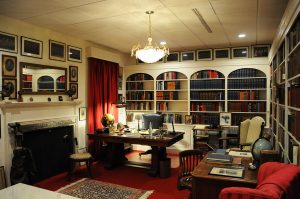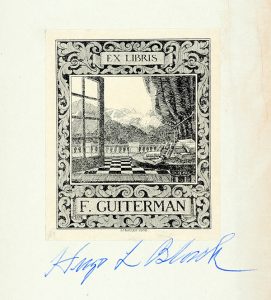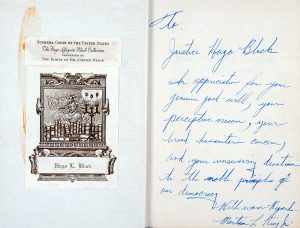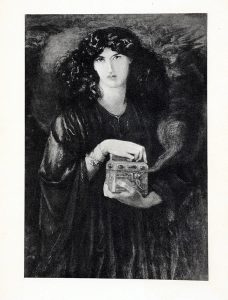The editors welcome this post from our colleague, Dr. Julie Seraphina Griffith, that offers a glimpse into the home study of United States Supreme Court Justice Hugo Black through descriptions of its furnishings and numerous books.
The Hugo Black Study at the Bounds Law Library
The Hugo L. Black Collection consists of over one thousand books, personal correspondence, tapes and transcripts of interviews, descriptions of court decisions, office materials, biographical and bibliographical information, photographs, student papers, lecture notes, and personal memorabilia. The collection is stored in several different locations throughout the Bounds Law Library. Hugo Lafayette Black (1886-1971) was born in Clay County, Alabama, and is one of the most distinguished graduates of the University of Alabama’s law school. He served two terms as a United States Senator from 1926-1937, and was an Associate Justice of the United States Supreme Court from 1937 until 1971. Black died shortly after his retirement.
The Hugo L. Black Collection books are located in the Hugo Black Study, which was dedicated 40 years ago during ceremonies that celebrated the relocation of the School of Law in 1978 to a new building.

Renovations made in 2015 include lighting that makes the room and its contents much more visible. Photographic portraits of the Supreme Court can be seen adorning the tops of two walls. Black’s tennis racket is propped against the fireplace and his golf clubs are on the left. Items on Black’s desk include an exquisite black ocean globe, an Art Deco inspired design in which the color black represents the water rather than traditional blue. A smaller globe with blue oceans sits atop a typist’s desk placed by a wall of bookshelves. The Hugo Black Study is centrally located on the main floor of the library, adjacent to the Circulation and Reference Desks. Visitors are able to view the entirety of the study through a partial door that provides a full view of the room and its contents. The study is a replica of Black’s home study in Alexandria, Virginia. It was designed and built to accommodate all the original contents—everything is just as it was when Black was working there on a daily basis.
While the furnishings from Black’s home study in Alexandria, Virginia, were shipped to the library in 1973, most of his favorite books did not arrive until 1983. The study contains over one thousand books, including primary and secondary legal materials, a large collection of historical writings, and other genres. There are, of course, numerous works on law-related topics as well as many other books that reveal his broad reading interests. These range from Thomas Jefferson to poetry to tennis and instructions for playing bridge. Hugo Black was a well-read man.
The books have been catalogued and are now arranged on the shelves, not according to Black’s original shelving preferences but by Library of Congress call number order so that the books can be easily located for research purposes. [1] All the books are accessible via online catalog searches. These books have a location code that indicates their placement in the Hugo Black Study, and another code indicating that they are part of the larger holdings of the library’s John C. Payne Special Collections. [2]
Distinguishing features of Black’s books are the broad subject matter, variation of format—cheap paperback copies are juxtaposed with valuable rare books—and the fact that he read and reread the materials regularly. In some books, his written comments reveal an ongoing conversation between Black and the author.

In addition, Black wrote to himself as he reread the books, providing examples of how his thought developed regarding certain topics. Black valued content over container and regularly perused used bookstores and catalogs. Roger K. Newman’s biography of Black contains an entire chapter, entitled “Books Are My Friends,” devoted to Black’s reading habits in which he discusses Black’s literary friendships with Will Durant, Carl Sandburg, and Alfred Knopf, among others. For example, Knopf published a book of Black’s opinions and he “usually took Black to dinner” several times each year. [3]
The classics were a significant influence on Black’s mindset, ideas, and interpretations. He studied Latin and Greek at Ashland College in Clay County, Alabama. This lifelong interest began when, as a law student, he sat in on an undergraduate English course taught by Dr. Charles H. Barnwell. This course prompted his “ever-increasing interest in the literature, philosophy and history of ancient Greece and the Greek way of life.” [4] Biographer Howard Ball comments that Black’s books by and about Greek philosophers, poets, and historians “are worn from repeated use, underlined and replete with marginalia, [and] indicative of the personal conversations Black had with the authors of these books.” [5]
Black also gave these books to his grandchildren, and had both his wives and his law clerks read Pericles and Aristotle, among many other Greek authors. While Aristotle was Black’s “favorite author,” Edith Hamilton’s The Greek Way was Black’s favorite book and the first required reading that he assigned to new law clerks. [6] He was so fond of the works of Hamilton that he “literally coerced his children into reading them, with further admonitions to read Livy or Plutarch when the boys were in college or in the military.” [7] The books in Black’s study include two, five-volume sets of Plutarch’s Lives and Writings; one singular Modern Library edition; and a five-volume set of Essays and Miscellanies, with an introduction by Ralph Waldo Emerson. [8]
Among the vast array of valuable Hugo Black resources held by the Bounds Law Library is an autographed copy of Martin Luther King, Jr.’s book, Stride Toward Freedom. The library has shown this inscription to a variety of interested patrons, including local elementary schoolchildren and visiting legal scholars. The inscription reads; “To Justice Hugo Black, In appreciation for your genuine good-will, your perceptive vision, your broad humanitarian concern, and your unswerving devotion to the noble principles of our democracy, with warm regards, Martin King, Jr.”

The Hugo Black Study is extraordinary. In its totality, the study exists apart from its surroundings as an intact historical artifact. One of Black’s former law clerks, David Vann, upon seeing the study after it was relocated to the library, said that it was “kind of a shock really,” to see the study again. [10] Due to the careful preparation and design that went into the planning of the space, the room’s original furnishings, and the magic of Black’s books, the Hugo Black Study captures an authenticity of spirit that is as when Black used it almost fifty years ago. The essence of its atmosphere remains the same.
Julie Seraphina Griffith
[1] Griffith, Julie. “Digital Description and Access: The Hugo Black Collection at the University of Alabama School of Law Library.” A “New Voices” Award-Winning Paper presented at the 2002 Joint SCLA/SELA Conference. The Southeastern Librarian 51:3 (2003): 26-30.
[2] The Bounds Law Library Special Collections is named after former law professor John C. Payne.
[3] Newman, Roger K. Hugo Black: A Biography. 2nd edition. New York: Fordham University, 1997: 451-452.
[4] Black, Hugo L. “Reminiscences” Alabama Law Review 18:1 (1965): 3, 7.
[5] Ball, Howard. Hugo Black: Cold Steel Warrior. New York: Oxford University Press, 1996: 7.
[6] Newman, 445-446.
[7] Ball, 7.
[8] Plutarch’s Lives: the Translation called Dryden’s. Corrected from the Greek and revised by A. H. Clough. London: Sampson Low, Marston, Low, and Searle, 1974: 5 volumes. Plutarch’s Lives: the Translation called Dryden’s. Corrected from the Greek and revised by A.H. Clough. New York: Colonial, 1905: 5 volumes. Plutarch: The Lives of the Noble Grecians and Romans. Translated by John Dryden and revised by Arthur Hugh Clough. New York: Modern Library, 19-?. Plutarch’s Essays and Miscellanies: Comprising all his Works Collected under the Title of “Morals.” Translated from the Greek by several hands, Corrected and revised by William W. Goodwin. New York: Colonial, 1905: 5 volumes.

[10] Pruitt, Paul M., Jr. “The Return of Hugo Black: the Significance of the Hugo Black Collection at the University of Alabama” Alabama Law Review 43:1 (1991): 301.